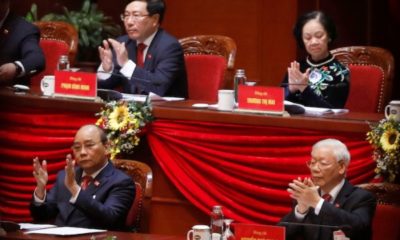As the US adopted an isolationist “America first” policy and turned its attention inward, middle powers in Asia, such as India and Japan, were confused by a growing Pan-Asia Railway network led by China. That is the geopolitical situation in Southeast Asia today.
Nguyen Luong Hai Khoi
Vietnam’s decision to complete the Lao Cai – Hanoi – Hai Phong railway line by 2030 has captured the interest of observers. This development coincides with China’s acceleration of its Pan-Asian Railway Network project, which will establish a new strategic political-economic landscape across the region.
The rapid expansion of China’s infrastructure diplomacy has already reshaped the Southeast Asian regional dynamics while U.S. Secretary of State Marco Rubio’s recent statements emphasizing America’s renewed focus on the Western Hemisphere, along with the defunding for Radio Free Asia, American soft power in Asia, posing the implication that the United States may not pay attention enough to areas of influence in the 20th century. Recently, global observers have been increasingly alert to China’s growing influence in Southeast Asia, a traditionally U.S.-aligned region.
China Inherits the Western Ideas
The idea of a transcontinental railway network, achieved by connecting a trans-Asian railway with a trans-European railway, dates back to the British and French colonial era. In 1900, these two empires devised a plan to construct a trans-Asian railway network. This network would begin in Kunming, China, and extend through Indochina (encompassing Vietnam, Laos, and Cambodia), Thailand, Malaysia, and finally, Singapore. In the early 1900s, several countries constructed sections of the Trans-Asian Railway network. France built multiple rail lines in Indochina at this time, including the Saigon-My Tho railway (1881), the Hanoi-Saigon line (1936), the Hanoi-Lao Cai line (1899-1906), and the Lao Cai (Vietnam)—Kunming (China) railway (1910). During World War II, Japan forced prisoners of war to construct a railway connecting Burma and Thailand.
The idea of a trans-Asian railway network was first introduced in the early 20th century but lost momentum in the mid-century as Western countries were pushed out of the region, and their influence declined.
The concept was revived in the 1990s, with a proposed route connecting Kunming, China, to Singapore via Hanoi, Saigon, Cambodia, Thailand, and Malaysia. China has expressed interest in completing the intercontinental railway and establishing itself as the central hub. After Xi Jinping assumed power in 2013, this railway network was incorporated into China’s Belt and Road Initiative (BRI). In 2025, Vietnam officially joined the network and plans to finish the Lao Cai – Hanoi – Hai Phong railway line by 2030 and construct a North-South high-speed railway.
Geopolitical Chessboard: Land vs. Sea and the Malacca Dilemma
The critical question ASEAN faces is how the Chinese-led Pan-Asian Railway Network, once established, will impact the region’s geopolitics and geo-economics. The Pan-Asian Railway Network is more than an economic endeavor; it’s a strategic maneuver. At its core lies China’s desire to secure its energy and trade lifelines.
The US Navy’s control of the Malacca Strait, a critical choke point for China’s Middle Eastern oil imports, presents a strategic vulnerability for Beijing. China’s response is multi-pronged: developing alternative land routes through Pakistan (the Middle East – Pakistan – Xinjiang route) and Myanmar (the Middle East – Myanmar – Kunming route). Moreover, China is constructing ports on both the Indian and South China Sea coasts in Malaysia. A railroad connecting these two ports will be built and linked to the Pan-Asian Railway Network. Upon completion, these ports and railways will enable China to bypass the Malacca Strait by transporting goods across the Malay Peninsula by rail to the Chinese-built port in Cambodia and then northward to China. Furthermore, the Malaysian government is contemplating a project extension to connect this railway to the Thai border. If implemented, this rail route would give China another option from Malaysia to China, bypassing the Malacca Strait.
China’s ambitions extend even further, as evidenced by its construction of a railway network connecting Laos, Thailand, Malaysia, and Singapore. While these are currently separate projects, the future implications of a fully connected network are significant. At that point, China will not even need to cross the Malacca Strait.
A part of China’s strategy is to use the land to confront the ocean, similar to Mao Zedong’s approach in the 1950s and 1960s. When faced with encirclement by the West and the US allies in the 1950s and 1960s, Mao moved closer to and cooperated with African, Latin American, and Non-Aligned Movement countries. Today, Xi Jinping, in response to ocean-based nations like the US and Japan, wants to focus on the potential of the Asia-Pacific region, the Eurasian continent, Central Asia, and Russia. In addition to the land route, China is also building a sea trade route, through the South China Sea into Southeast Asia, then the Indian Ocean and the Arab region, into Turkey, the Black Sea, the Baltic Sea, and finally Europe. This will connect the two continents of Asia and Europe.
What is ASEAN’s geopolitical and geo-economic position in the US-China competition when this China-led continental and oceanic transport network is fully interconnected shortly?
Opportunities and Challenges for Southeast Asia
The economic benefits of the railway network to Southeast Asia are undeniable. These include streamlined exports, enhanced connectivity, and support for multinational supply chains. However, these benefits also come with strategic costs.
The Pan-Asian Railway Network presents numerous economic opportunities. Professor Carl Thayer told RFA that the Lao Cai – Hai Phong railway, linking Vietnam and China, will streamline the export of key Vietnamese goods to China, including electronics, footwear, garments, rubber, wood, cotton, seafood, and fresh produce. Vietnam’s current railway system, a relic of the French colonial era, is ill-equipped to handle modern economic activity. Road transport is expensive, and border stations create bottlenecks that impede cross-border transit, particularly affecting perishable goods. The railway will also enable multinational companies like Foxconn, Pegatron, and Samsung to efficiently transport equipment and components from southern China to northern Vietnam and Hai Phong port, expediting exports for both countries.
However, China’s infrastructure investment comes with a cost. Southeast Asian countries are required to take on debt, often from China, to finance these projects. This raises concerns about the financial implications and potential dependence on China for these nations.
Given the questionable benefits and high costs, should less developed Southeast Asian countries invest significantly in supporting China’s strategic goals?
According to Professor Zachary Abuza at National War College, the completion and connection of the Lao Cai – Hanoi – Hai Phong railway line to the Chinese railway network could significantly limit Vietnam’s strategic maneuverability, specifically due to China’s influence. When Southeast Asian markets, including Vietnam’s, are directly connected to the world’s largest manufacturing base via cheaper, faster, and more convenient transportation, they will have limited room to maneuver.
While promoting trade can stimulate significant financial growth and investment, it is crucial to ensure equitable distribution of benefits. If trade between Southeast Asia and China remains limited to the exchange of Southeast Asian raw materials for Chinese manufactured goods, only China will reap the rewards. Dr. Nagao Satori, a research fellow at the Hudson Institute and lecturer at Gakushuin University, Tokyo, told RFA that to avoid this imbalance, Southeast Asian countries, including Vietnam, should prioritize infrastructure investment while exercising caution before entering into the Version 3.0 free trade agreements with China.
Navigating the Eurasian Pivot
Southeast Asia stands at a pivotal moment. The Pan-Asian Railway Network presents both opportunities and challenges, requiring a delicate balancing act. Nations must carefully weigh the economic benefits against the potential for strategic dependency.
The future of the region hinges on the strategic choices of the US, its allies, and Southeast Asian nations themselves. As China’s Eurasian ambitions unfold, the region must navigate this complex geopolitical landscape with foresight and strategic clarity.
“Offensive realism” postulates that great powers seek to maximize their security by consolidating their regional spheres of influence while simultaneously undermining those of their rivals. This dynamic is exemplified by China’s expanding influence in Southeast Asia, notably through the Pan-Asia Railway network within the Belt and Road Initiative (BRI), concurrent with its growing engagement in South America.
As reported in the Wall Street Journal on January 30, 2025, U.S. Secretary of State Marco Rubio articulated a renewed U.S. focus on the Western Hemisphere, signaling an effort to reassert influence in a region where Chinese penetration has occurred. However, in Southeast Asia, the U.S. has arguably created a strategic vacuum, enabling China to solidify its geopolitical position. The U.S.’s perceived inward turn has created uncertainty among regional middle powers, such as India and Japan, regarding the implications of China’s expanding Pan-Asia Railway network. This situation characterizes the contemporary geopolitical landscape of Southeast Asia. The future trajectory of this dynamic hinges on the strategic decisions of the United States in conjunction with its Asian allies and partners, including Japan and India.
The Eurasian Tightrope: Balancing Ambition and Autonomy in Southeast Asia
Southeast Asia now walks a geopolitical tightrope, balancing the allure of economic integration with the imperative of strategic autonomy. China’s Pan-Asian Railway Network is not merely a conduit for goods; it’s a lever of influence, demanding a nuanced response from regional states. They must meticulously weigh the immediate economic gains against the long-term risks of strategic dependency and potential debt traps.
The future of Southeast Asia hinges on a complex interplay of strategic choices. First, Southeast Asian nations must forge a unified and resilient approach, prioritizing regional cooperation over individual concessions. Second, the United States, under its “offensive realism” doctrine, must demonstrate a consistent and credible commitment to the region, countering China’s growing influence.
The Japan-led Asian Development Bank (ADB) funded the East-West Economic Corridor (EWEC) as part of the Greater Mekong Subregion (GMS) initiative. India initiated this highway project to compete with China’s Pan-Asia railway network, to connect India to Vietnam through Myanmar, Thailand, and Laos. This route remains incomplete due to financial constraints, civil war in Burma, and loose cooperation between Southeast Asian countries and regional powers such as India and Japan. The EWEC’s stalled progress underscores the difficulties of competing with China’s cohesive, state-driven approach.
Ultimately, the trajectory of Southeast Asia will be determined by the strategic calculations of both regional and global actors. Southeast Asian nations must assert their agency, diversify their partnerships, and strengthen their collective resilience. The US, alongside its allies, must demonstrate a sustained commitment to offering viable alternatives to China’s infrastructure-driven influence. The region’s future is not predetermined; it rests on the strategic choices made today, choices that will shape the balance of power in the heart of Eurasia for decades to come.

 Politics & Economy4 years ago
Politics & Economy4 years ago
 Politics & Economy1 year ago
Politics & Economy1 year ago
 Society & Culture5 years ago
Society & Culture5 years ago
 ARCHIVES5 years ago
ARCHIVES5 years ago
 Politics & Economy4 years ago
Politics & Economy4 years ago
 Politics & Economy5 years ago
Politics & Economy5 years ago
 After 19751 year ago
After 19751 year ago
 Politics & Economy4 years ago
Politics & Economy4 years ago







